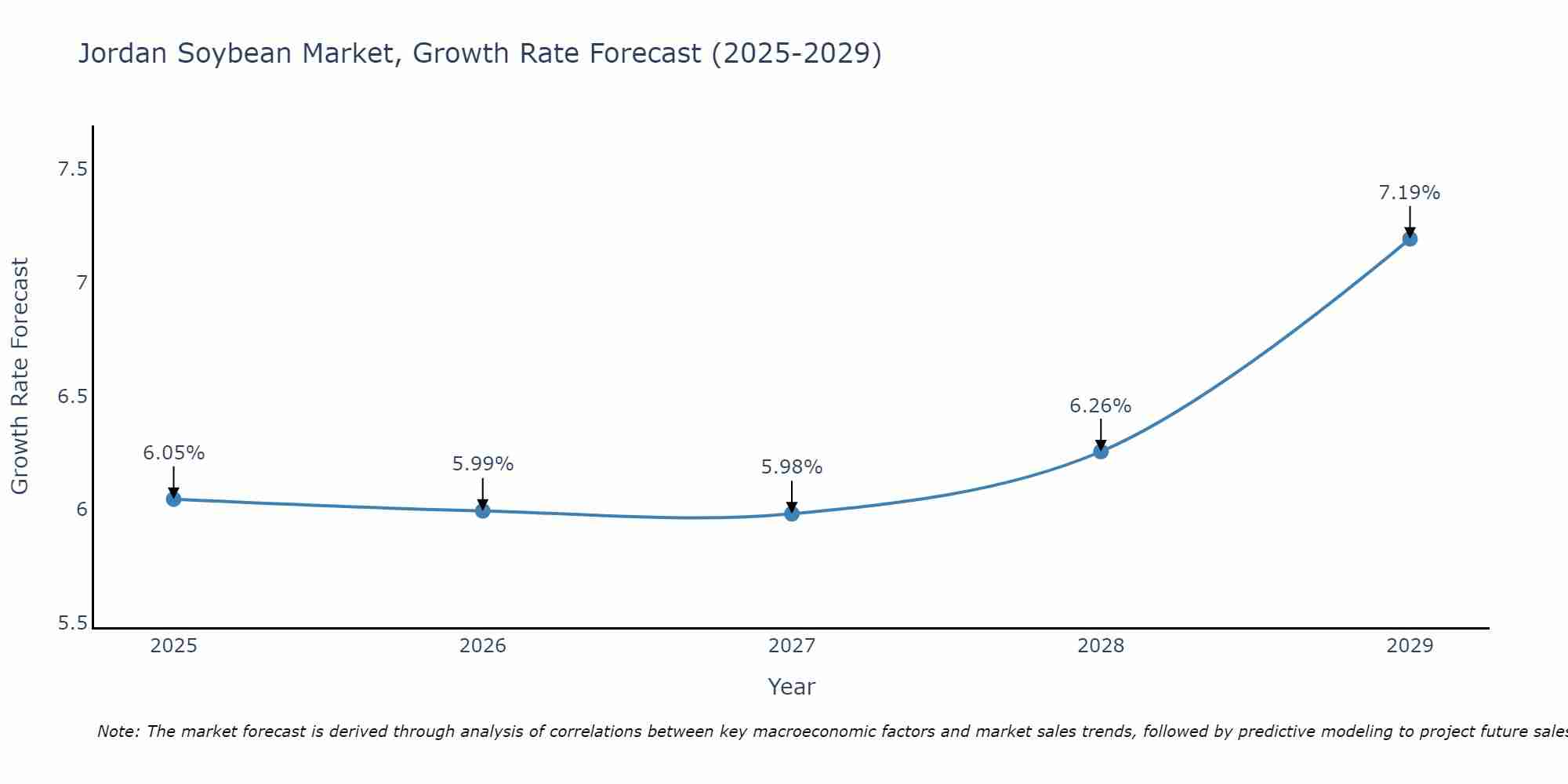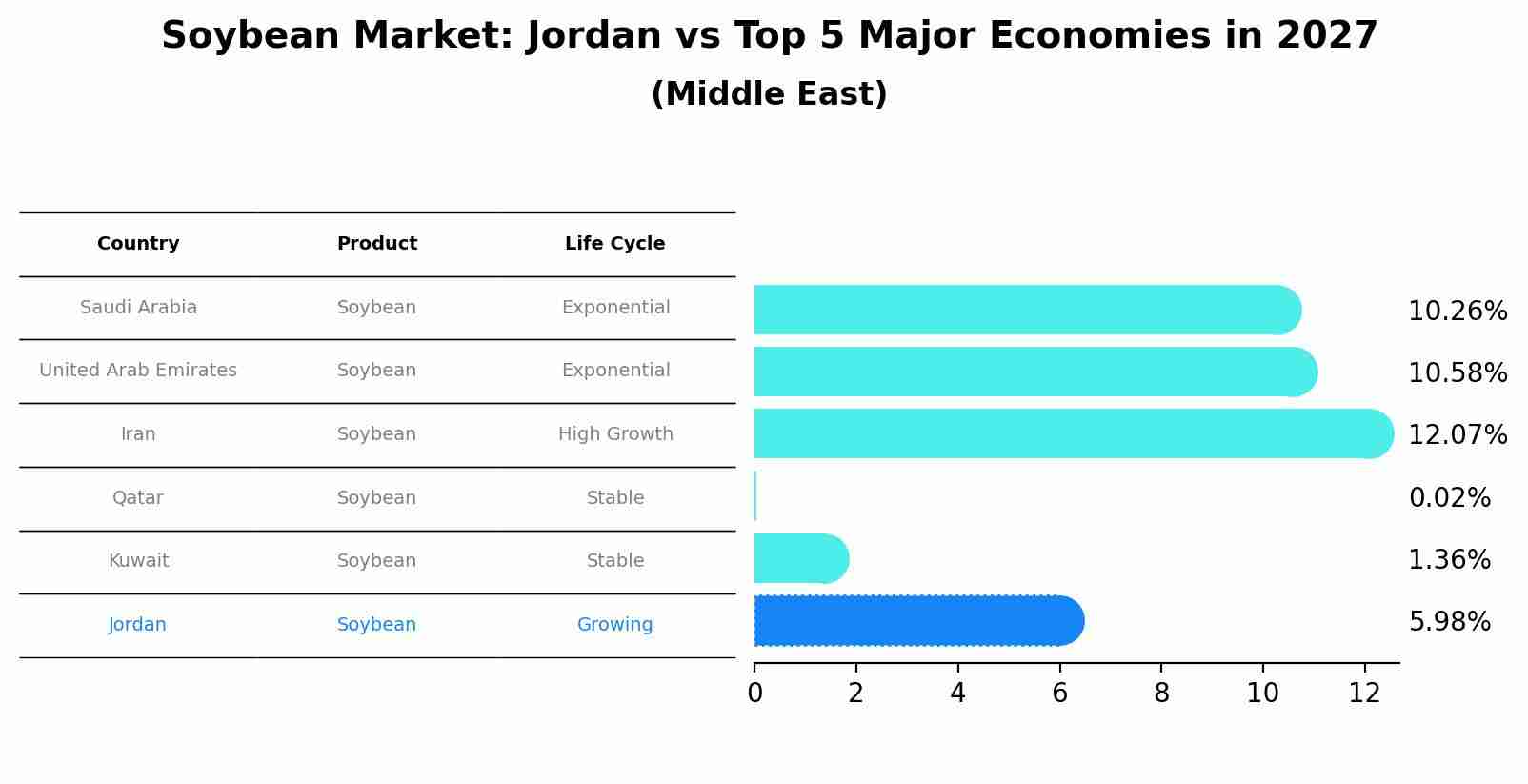Jordan Soybean Market Outlook | Share, Companies, Value, Forecast, Size, Growth, Industry, Trends, Analysis, Revenue & COVID-19 IMPACT
| Product Code: ETC224686 | Publication Date: Aug 2022 | Updated Date: Aug 2025 | Product Type: Market Research Report | |
| Publisher: 6Wresearch | Author: Sumit Sagar | No. of Pages: 75 | No. of Figures: 35 | No. of Tables: 20 |
Jordan Soybean Market Size Growth Rate
The Jordan Soybean Market is projected to witness mixed growth rate patterns during 2025 to 2029. The growth rate starts at 6.05% in 2025 and reaches 7.19% by 2029.

Soybean Market: Jordan vs Top 5 Major Economies in 2027 (Middle East)
The Soybean market in Jordan is projected to grow at a growing growth rate of 5.98% by 2027, within the Middle East region led by Saudi Arabia, along with other countries like United Arab Emirates, Iran, Qatar and Kuwait, collectively shaping a dynamic and evolving market environment driven by innovation and increasing adoption of emerging technologies.

Jordan Soybean Market Overview
The Jordan soybean market is characterized by a growing demand for soybean products due to their nutritional benefits and versatility in various industries such as food, animal feed, and biofuels. The country relies heavily on soybean imports to meet its domestic needs, with the United States being a significant supplier. Jordan`s increasing population and changing dietary preferences towards healthier options are driving the demand for soybean products. The government`s efforts to promote sustainable agriculture practices and reduce dependency on imports could potentially boost domestic soybean production in the future. Overall, the Jordan soybean market presents opportunities for both local and international suppliers to cater to the growing demand for soybean-derived products in the country.
Jordan Soybean Market Trends
The Jordan Soybean Market is currently witnessing a notable trend towards increased consumption of soybean products due to the growing awareness of their health benefits and versatility in various cuisines. This trend is supported by a rising preference for plant-based protein sources among health-conscious consumers. Additionally, the market is experiencing a shift towards sustainable and ethically sourced soybeans, driven by the demand for environmentally friendly and socially responsible products. The popularity of soybean-based products such as soy milk, tofu, and meat alternatives is also contributing to the overall growth of the market. As consumers become more mindful of their dietary choices and environmental impact, the Jordan Soybean Market is expected to continue evolving to meet these changing preferences and demands.
Jordan Soybean Market Challenges
In the Jordan soybean market, several challenges are faced, including limited arable land for cultivation, water scarcity, and reliance on imports for soybean products. The country`s arid climate and limited resources make it difficult to expand soybean cultivation, leading to a heavy reliance on imports to meet domestic demand. Additionally, water scarcity poses a significant challenge for agricultural production, impacting soybean cultivation in Jordan. The market also faces competition from other oilseed crops and economic factors affecting import costs. These challenges highlight the need for sustainable agricultural practices, water conservation efforts, and diversification of the agricultural sector to enhance the competitiveness and resilience of the Jordan soybean market.
Jordan Soybean Market Investment Opportunities
Investment opportunities in the Jordan Soybean Market include potential for growth due to increasing demand for soybean products in various industries such as food processing, animal feed production, and biofuel manufacturing. The market is relatively underdeveloped in Jordan, presenting opportunities for investors to enter and establish soybean cultivation, processing facilities, or trading ventures. Additionally, government initiatives to promote agriculture and reduce reliance on imports could create a favorable environment for investments in the soybean sector. With a strategic location in the Middle East and access to regional markets, investors can leverage Jordan`s position to capitalize on the growing demand for soybean products in the region. Conducting thorough market research, understanding regulatory frameworks, and forming strategic partnerships will be essential for success in the Jordan Soybean Market.
Jordan Soybean Market Government Policy
The Jordanian government has implemented various policies to support the soybean market, including import tariffs and subsidies. Import tariffs are imposed on imported soybeans to protect domestic producers and encourage local production. Additionally, the government provides subsidies to soybean farmers to enhance production efficiency and competitiveness. These policies aim to stabilize the soybean market, ensure food security, and reduce reliance on imports. The government also works to promote sustainable agricultural practices to support the growth of the soybean industry in Jordan. Overall, these policies play a crucial role in shaping the soybean market in Jordan and supporting the country`s agricultural sector.
Jordan Soybean Market Future Outlook
The future outlook for the Jordan soybean market appears promising due to increasing consumer demand for plant-based protein sources and the government`s initiatives to promote domestic agriculture. With a growing awareness of the health and environmental benefits of soy products, there is a potential for further expansion of the market. Additionally, advancements in agricultural technology and practices are expected to improve soybean yields and quality in Jordan. However, challenges such as water scarcity and climate change could impact production in the long term, necessitating sustainable farming practices and efficient water management strategies to ensure the continued growth of the soybean market in Jordan.
Key Highlights of the Report:
- Jordan Soybean Market Outlook
- Market Size of Jordan Soybean Market, 2021
- Forecast of Jordan Soybean Market, 2031
- Historical Data and Forecast of Jordan Soybean Revenues & Volume for the Period 2018 - 2031
- Jordan Soybean Market Trend Evolution
- Jordan Soybean Market Drivers and Challenges
- Jordan Soybean Price Trends
- Jordan Soybean Porter's Five Forces
- Jordan Soybean Industry Life Cycle
- Historical Data and Forecast of Jordan Soybean Market Revenues & Volume By Applications for the Period 2018 - 2031
- Historical Data and Forecast of Jordan Soybean Market Revenues & Volume By Crush for the Period 2018 - 2031
- Historical Data and Forecast of Jordan Soybean Market Revenues & Volume By Feed Use for the Period 2018 - 2031
- Historical Data and Forecast of Jordan Soybean Market Revenues & Volume By Food Use for the Period 2018 - 2031
- Jordan Soybean Import Export Trade Statistics
- Market Opportunity Assessment By Applications
- Jordan Soybean Top Companies Market Share
- Jordan Soybean Competitive Benchmarking By Technical and Operational Parameters
- Jordan Soybean Company Profiles
- Jordan Soybean Key Strategic Recommendations
Frequently Asked Questions About the Market Study (FAQs):
1 Executive Summary |
2 Introduction |
2.1 Key Highlights of the Report |
2.2 Report Description |
2.3 Market Scope & Segmentation |
2.4 Research Methodology |
2.5 Assumptions |
3 Jordan Soybean Market Overview |
3.1 Jordan Country Macro Economic Indicators |
3.2 Jordan Soybean Market Revenues & Volume, 2021 & 2031F |
3.3 Jordan Soybean Market - Industry Life Cycle |
3.4 Jordan Soybean Market - Porter's Five Forces |
3.5 Jordan Soybean Market Revenues & Volume Share, By Applications, 2021 & 2031F |
4 Jordan Soybean Market Dynamics |
4.1 Impact Analysis |
4.2 Market Drivers |
4.2.1 Increasing awareness about the health benefits of soybeans |
4.2.2 Growing demand for plant-based proteins in Jordan |
4.2.3 Favorable government policies supporting soybean cultivation |
4.3 Market Restraints |
4.3.1 Limited availability of arable land for soybean cultivation in Jordan |
4.3.2 Dependence on imports for soybean supply |
4.3.3 Fluctuating prices of soybeans in the global market |
5 Jordan Soybean Market Trends |
6 Jordan Soybean Market, By Types |
6.1 Jordan Soybean Market, By Applications |
6.1.1 Overview and Analysis |
6.1.2 Jordan Soybean Market Revenues & Volume, By Applications, 2021-2031F |
6.1.3 Jordan Soybean Market Revenues & Volume, By Crush, 2021-2031F |
6.1.4 Jordan Soybean Market Revenues & Volume, By Feed Use, 2021-2031F |
6.1.5 Jordan Soybean Market Revenues & Volume, By Food Use, 2021-2031F |
7 Jordan Soybean Market Import-Export Trade Statistics |
7.1 Jordan Soybean Market Export to Major Countries |
7.2 Jordan Soybean Market Imports from Major Countries |
8 Jordan Soybean Market Key Performance Indicators |
8.1 Percentage increase in soybean consumption in Jordan |
8.2 Number of new soybean farming initiatives in the country |
8.3 Average yield per hectare of soybeans in Jordan |
9 Jordan Soybean Market - Opportunity Assessment |
9.1 Jordan Soybean Market Opportunity Assessment, By Applications, 2021 & 2031F |
10 Jordan Soybean Market - Competitive Landscape |
10.1 Jordan Soybean Market Revenue Share, By Companies, 2021 |
10.2 Jordan Soybean Market Competitive Benchmarking, By Operating and Technical Parameters |
11 Company Profiles |
12 Recommendations |
13 Disclaimer |
- Single User License$ 1,995
- Department License$ 2,400
- Site License$ 3,120
- Global License$ 3,795
Search
Thought Leadership and Analyst Meet
Our Clients
Related Reports
- Afghanistan Apparel Market (2026-2032) | Growth, Outlook, Industry, Segmentation, Forecast, Size, Companies, Trends, Value, Share, Analysis & Revenue
- Canada Oil and Gas Market (2026-2032) | Share, Segmentation, Value, Industry, Trends, Forecast, Analysis, Size & Revenue, Growth, Competitive Landscape, Outlook, Companies
- Germany Breakfast Food Market (2026-2032) | Industry, Share, Growth, Size, Companies, Value, Analysis, Revenue, Trends, Forecast & Outlook
- Australia Briquette Market (2025-2031) | Growth, Size, Revenue, Forecast, Analysis, Trends, Value, Share, Industry & Companies
- Vietnam System Integrator Market (2025-2031) | Size, Companies, Analysis, Industry, Value, Forecast, Growth, Trends, Revenue & Share
- ASEAN and Thailand Brain Health Supplements Market (2025-2031) | Strategy, Consumer Insights, Analysis, Investment Trends, Opportunities, Growth, Size, Share, Industry, Revenue, Segments, Value, Segmentation, Supply, Forecast, Restraints, Outlook, Competition, Drivers, Trends, Demand, Pricing Analysis, Competitive, Strategic Insights, Companies, Challenges
- ASEAN Bearings Market (2025-2031) | Strategy, Consumer Insights, Analysis, Investment Trends, Opportunities, Growth, Size, Share, Industry, Revenue, Segments, Value, Segmentation, Supply, Forecast, Restraints, Outlook, Competition, Drivers, Trends, Demand, Pricing Analysis, Competitive, Strategic Insights, Companies, Challenges
- Europe Flooring Market (2025-2031) | Outlook, Share, Industry, Trends, Forecast, Companies, Revenue, Size, Analysis, Growth & Value
- Saudi Arabia Manlift Market (2025-2031) | Outlook, Size, Growth, Trends, Companies, Industry, Revenue, Value, Share, Forecast & Analysis
- Uganda Excavator, Crane, and Wheel Loaders Market (2025-2031) | Strategy, Consumer Insights, Analysis, Investment Trends, Opportunities, Growth, Size, Share, Industry, Revenue, Segments, Value, Segmentation, Supply, Forecast, Restraints, Outlook, Competition, Drivers, Trends, Demand, Pricing Analysis, Competitive, Strategic Insights, Companies, Challenges
Industry Events and Analyst Meet
Whitepaper
- Middle East & Africa Commercial Security Market Click here to view more.
- Middle East & Africa Fire Safety Systems & Equipment Market Click here to view more.
- GCC Drone Market Click here to view more.
- Middle East Lighting Fixture Market Click here to view more.
- GCC Physical & Perimeter Security Market Click here to view more.
6WResearch In News
- Doha a strategic location for EV manufacturing hub: IPA Qatar
- Demand for luxury TVs surging in the GCC, says Samsung
- Empowering Growth: The Thriving Journey of Bangladesh’s Cable Industry
- Demand for luxury TVs surging in the GCC, says Samsung
- Video call with a traditional healer? Once unthinkable, it’s now common in South Africa
- Intelligent Buildings To Smooth GCC’s Path To Net Zero


















